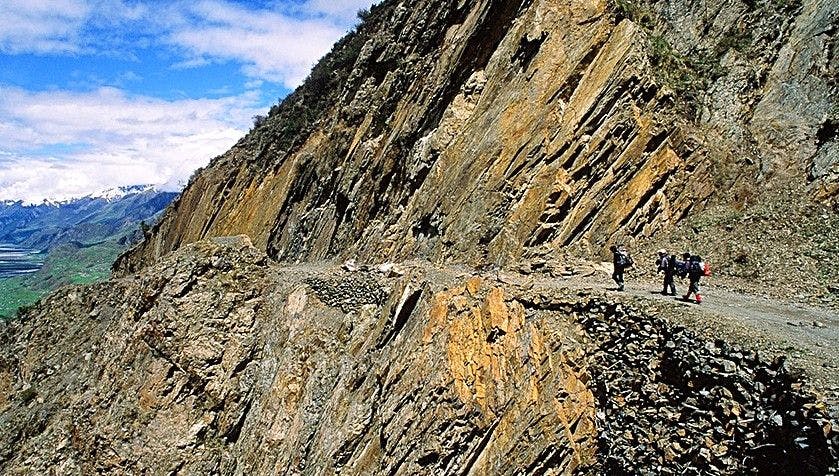The Other Silk Route
BOOKMARK
While we know of the great Silk Road which passed from China, through Central Asia, to Constantinople (Istanbul) , there was another very important trade route known as the ‘Southern Silk route’, or the ‘Tea-Horse Road’ which was a critical economic lifeline for China, Tibet and the Himalayan kingdoms of North-East India for over 1900 years. This trade route passed from Sichuan and Yunan provinces in South West China, through Tibet and the Nathula pass in Sikkim, down to the ports of Bengal in India. Perilous to navigate through, the Tea-Horse road locally referred to as the Cha-ma-gu-dao, as the name suggests, was mostly used for bringing in tea from China and taking back wool, medicines and warhorses from Tibet. From India, it was the more exotic spices, corals, pearls, and incense that made their way out. In active use from 2nd BCE all the way to the 17th century CE, the traders on this route had to make their way through some of the most dangerous mountains like the Hengduan mountain range spanning the west side of Sichuan and Yunnan provinces of China and the southeast of Tibet, gorges and rough rivers which were crossed through bridges sometimes made of a single rope. But it was crucial as it connected China (Sichuan and Yunan) to Tibet, India, Nepal and Bhutan.
The trade between China, Tibet and India through this route went all the way back to the rule of the Western Han Dynasty of China between 206 BCE - 24 CE. Yunnan is one of the oldest tea growing region in the world and this tea was sold to the Tibetans in exchange for Tibetan Yaks. However, this route grew in importance later during the reign of the Tang Dynasty (618-960 CE) of China, when increasing disturbances in northern and western parts of China led to a great demand for Tibetan warhorses. The Chinese Emperor formed an alliance with the Tibetan King, Songsten Gambo in 641 CE, where the exchange arrangement of ‘Tea for Horses’ was formalized. Tea produced in Yunnan was shaped into bricks and wrapped in bamboo leaves for transport. Men carried huge loads of this cargo all the way to Tibet. One Tibetan war horse was exchanged for 20-60 kgs of tea depending on the quality. This tea was then brought to India through the Nathula pass in Sikkim.
Over time, the trade moved beyond tea and horses. Caravans shuttled back and forth carrying tea from China and taking back wool, medicines and warhorses from Tibet and spices, corals, pearls, glass vessels, beads, incense and perfume from India. Unlike the other trade routes, which were fortified with garrisons and fortresses, the inhospitable terrain of the Tea-Horse route meant that hardly any attempts were made to control this route. The Tea-Horse route was significant not just for trade, but also for faith. It acted as a highway for cultural exchange and it is from here and the Silk route that Buddhist teachings spread across the Himalayan kingdoms and into China. Monks from Varanasi, Odisha and Bengal travelled to Tibet and Yunnan regions of China through this route. The importance of this Tea-Horse road declined with the advances in maritime technology in the 17th and the 18th centuries. When the British East India Company establishing its control over Bengal and parts of North East, most of the trade between India and China shifted to the sea ports. By now the demand for Chinese tea in the region had also declined as the British set up tea plantations across Assam.
Though trade at the Nathula pass had become just a trickle, in 1873, recognising the strategic importance of the Himalayan passes between Sikkim and Tibet, the Deputy Commissioner of Darjeeling announced the setting of a formal trading post in Nathula in 1894. In 1904, the British went beyond, crossing Nathula to capture Lhasa in order to prevent Russia’s interference in Tibet. British posts were now set up all over Tibet. The old Tea-Horse route came into prominence again during World War II, when the Japanese Army occupied coastal China and Myanmar where they blocked the road that led to India via Myanmar. To counter this Japanese presence Allied Forces led by America used this route to send personnel and supplies to Chinese and American forces It is estimated that as many as 25,000 mules and horses were used to transport goods and services across the Nathula pass.
However, with the Chinese Occupation of Tibet in 1950, and the Nathula pass being used as a route by the Tibetan refugees to cross into India, the trade at Nathula pass was severely restricted. It was opened and then again shut after the India-China war of 1962. It was reopened in 2007. Picturesque, brutal and significant many term the Tea-Horse Road as the ‘Eternal Road’. In active for over 1500 years this southern Silk Route played a critical role, creating the cultural edifice of the region, as we see it today.|The ‘Southern Silk Road’ was the economic lifeline of the Himalayan kingdoms. Discover this faded trail...









